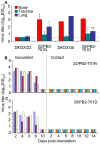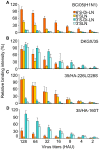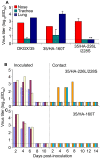Identification of amino acids in HA and PB2 critical for the transmission of H5N1 avian influenza viruses in a mammalian host
- PMID: 20041223
- PMCID: PMC2791199
- DOI: 10.1371/journal.ppat.1000709
Identification of amino acids in HA and PB2 critical for the transmission of H5N1 avian influenza viruses in a mammalian host
Abstract
Since 2003, H5N1 influenza viruses have caused over 400 known cases of human infection with a mortality rate greater than 60%. Most of these cases resulted from direct contact with virus-contaminated poultry or poultry products. Although only limited human-to-human transmission has been reported to date, it is feared that efficient human-to-human transmission of H5N1 viruses has the potential to cause a pandemic of disastrous proportions. The genetic basis for H5N1 viral transmission among humans is largely unknown. In this study, we used guinea pigs as a mammalian model to study the transmission of six different H5N1 avian influenza viruses. We found that two viruses, A/duck/Guangxi/35/2001 (DKGX/35) and A/bar-headed goose/Qinghai/3/2005(BHGQH/05), were transmitted from inoculated animals to naïve contact animals. Our mutagenesis analysis revealed that the amino acid asparagine (Asn) at position 701 in the PB2 protein was a prerequisite for DKGX/35 transmission in guinea pigs. In addition, an amino acid change in the hemagglutinin (HA) protein (Thr160Ala), resulting in the loss of glycosylation at 158-160, was responsible for HA binding to sialylated glycans and was critical for H5N1 virus transmission in guinea pigs. These amino acids changes in PB2 and HA could serve as important molecular markers for assessing the pandemic potential of H5N1 field isolates.
Conflict of interest statement
The authors have declared that no competing interests exist.
Figures








References
-
- Vong S, Ly S, Van Kerkhove MD, Achenbach J, Holl D, et al. Risk factors associated with subclinical human infection with avian influenza A (H5N1) virus–Cambodia, 2006. J Infect Dis. 2009;199:1744–1752. - PubMed
-
- Claas EC, Osterhaus AD, van Beek R, De Jong JC, Rimmelzwaan GF, et al. Human influenza A H5N1 virus related to a highly pathogenic avian influenza virus. Lancet. 1998;351:472–477. - PubMed
-
- Subbarao K, Klimov A, Katz J, Regnery H, Lim W, et al. Characterization of an avian influenza A (H5N1) virus isolated from a child with a fatal respiratory illness. Science. 1998;279:393–396. - PubMed
Publication types
MeSH terms
Substances
LinkOut - more resources
Full Text Sources
Medical

